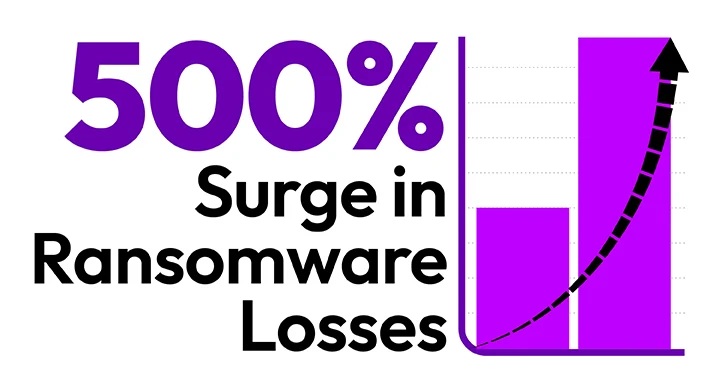
The cybersecurity threat landscape has witnessed a dramatic and alarming rise in the average ransomware payment, an increase exceeding 500%. Sophos, a global leader in cybersecurity, revealed in its annual “State of Ransomware 2024” report that the average ransom payment has increased 500% in the last year with organizations that paid a ransom reporting an average payment of $2 million, up from $400,000 in 2023. Separately, RISK & INSURANCE, a leading media source for the insurance industry reported recently that in 2023 the median ransom demand soared to $20 million in 2023 from $1.4 million in 2022, and payment skyrocketed to $6.5 million in 2023 from $335,000 in 2022, much more than 500%.
This shocking surge is a testament to the increasing sophistication of cyberattacks and the significant vulnerabilities inherent in outdated security methods. The most significant factor contributing to this trend is a broad reliance on twenty-year-old, legacy Multi-Factor Authentication (MFA), which is proving entirely inadequate against modern cyberattacks. Moreover, the adoption of Generative AI has enabled cybercriminals to craft remarkably convincing phishing attacks, making them nearly undetectable to even well-trained users. This article explores the reasons behind the rapid increase in average ransomware payments, the shortcomings of legacy MFA, and the need for next-generation MFA solutions.
In pursuit of ever-increasing ransom payments, cybercriminals have refocused their efforts and tactics to identify and cripple organizations where they can cause the greatest interruption in operations to extract the largest ransom payments. Examples include the $100 million loss by MGM, the billion-dollar-plus loss by Change HealthCare, and the yet-to-be determined losses by CDK Global. Cybercriminals are acutely aware of this economic calculus and leverage it to demand exorbitant sums, knowing that victims are likely to comply to minimize losses. It is a simple yet painful business decision for the victim.
Generative AI technologies have revolutionized the way cybercriminals create phishing emails. These tools generate highly convincing and personalized phishing messages free from grammatical and spelling errors that are indistinguishable from legitimate communications. By analyzing vast amounts of data, Generative AI can mimic writing styles, create believable scenarios, and target individuals with precision. These attacks convincingly mimic emails from trusted sources, complete with accurate branding and contextually relevant information. Organizations that rely on employee training as a defense strategy are increasingly seeing diminishing returns for their investment.

Protect your organization from rising ransomware losses with phishing-resistant MFA. Download the white paper “Secure Your Data with Phishing-Resistant MFA” to discover how next-generation wearable MFA can protect your sensitive information and overcome the shortcomings of legacy solutions.
Multi-Factor Authentication (MFA) has been a mainstay of perimeter security for decades, designed to enhance the protection of enterprise networks by requiring multiple forms of verification. However, legacy MFA systems including Knowledge Based Authentication (KBA), One Time Passwords (OTP), and authentication apps, developed twenty years ago, are increasingly inadequate against modern cyberattacks. Legacy MFA has been defeated in the overwhelming majority of successful ransomware attacks. Legacy MFA is now quickly compromised by cybercriminals in the following ways.
To effectively combat the virtual tsunami of ransomware attacks, organizations must consider phishing-resistant, next-generation MFA technologies. These advanced solutions incorporate a range of sophisticated authentication factors, including biometrics (such as fingerprint and facial recognition making it significantly harder for cybercriminals to replicate or compromise. This is increasingly relevant when considering that the Verizon Data Breach Incident Report consistently reports that more than two-thirds of breaches are the result of compromised credentials and the Cybersecurity and Infrastructure Security Agency (CISA), an agency of the DHS reports that 90% of successful ransomware attacks are the result of phishing attacks.
Biometric authentication leverages the unique physical attributes of authorized users such as their fingerprints, facial characteristics, and other traits that are extremely difficult to forge or steal. Biometrics play a crucial role in next-generation Multi-Factor Authentication (MFA) due to several key benefits and unique characteristics:
Biometrics offers a quick and seamless authentication process, often just requiring a scan or touch, enhancing the user experience. No passwords for users to memorize or dongles to avoid losing. This reduces the burden on users and minimizes errors, lockouts, and helpdesk calls.
In summary, user convenience in MFA solutions is essential to ensure high adoption rates, reduce errors and support costs, enhance security, maintain productivity, and improve overall user satisfaction. By balancing security with ease of use, organizations can create an effective security environment that is both effective and user-friendly.
Selecting the appropriate phishing-resistant, next-generation MFA solution requires careful consideration of the organization’s unique requirements. Factors to consider include the types of authentication factors supported, integration capabilities, ease of use, and scalability. Organizations should opt for solutions that offer a balance of security, usability, and flexibility.
Implementing next-generation MFA should be approached in phases to minimize disruption and ensure a smooth transition. This phased approach allows for thorough testing and user acclimatization.
The cybersecurity landscape is constantly evolving, and so must an organization’s security measures. Continuous monitoring and regular updates are crucial to maintaining the effectiveness of phishing-resistant and next-generation MFA solutions. Organizations should establish a framework for ongoing security assessments, system updates, and threat intelligence integration to stay ahead of emerging threats.
Reference: https://thehackernews.com/2024/07/how-mfa-failures-are-fueling-500-surge.html